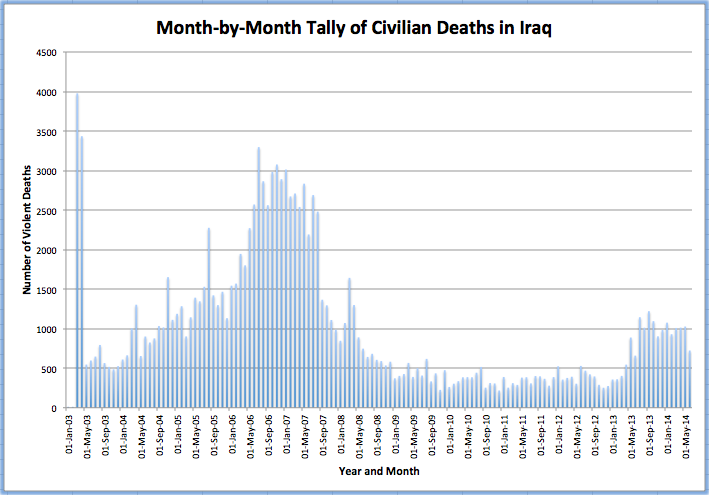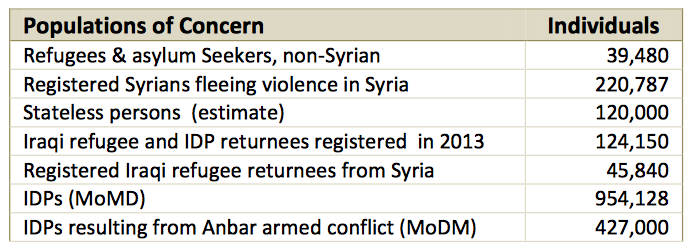Now that Iraq is front page news again, I thought it was a good time to look at the cost of the war in Iraq that began on March 20, 2003 in terms that we can relate to, the cost to humans.
A study by the Watson Institute for International Studies at Brown University takes a detailed look at the total cost of the Iraq war, examining the number of American soldiers killed or wounded, civilian casualties and the economic costs of the war. The study involved more than 30 economists, lawyers, political scientists, humanitarians and anthropologists.
Let's look at the key findings of the study and see how high the human costs of the war have been:
U.S. Military – 4489
U.S. Contractors – 3455
Iraqi Military and Police – 12096
Other Allied Troops – 318
That brings the total military and police forces killed between March 2003 and April 2014 to 20,358. Even though United States troops officially withdrew from Iraq in December 2011, there are still over 5000 American contractors working at security guards, training Iraqi troops etcetera.
Interestingly, according to AntiWar, the official number of wounded American military personnel stands at "only" 32,021. Even the Department of Veterans Affairs admits that there are many environmental and chemical hazards that military personnel may have encountered during their time in Iraq that could lead to long-term health problems. Research by the National Center for PTSD suggests that between 10 and 18 percent of Operation Iraqi Freedom troops are likely to have PTSD after they return home. This, along with the issue of environmentally-related long-term health problems, will push the number of wounded far, far higher than 32,000.
2.) Civilians Killed:
An interesting and sobering website, Iraqi Body Count, does a day-by-day count of Iraqis killed, where they were killed and how they were killed. Their data is drawn from media reports, hospital and morgue data and information from NGOs. Between June 1 and June 12, 2014, 701 Iraqi civilians were killed, bringing the documented civilian death count to between 124,573 and 138,882.
Here is a graph showing the monthly tally of Iraqi civilians killed by war-related violence connected to the ongoing "nation rebuilding":
Notice how the number of civilian casualties has doubled from less than 500 per month to over 1000 per month since mid-2013? It is important to note that the data from October 2013 onward is still preliminary since the data is based on single-sourced reports and that it may rise or fall depending on complete analysis.
In addition, the war-related damage to the nation's infrastructure has most likely led to additional deaths that were non-violent. Damage to the food and water supply systems, hospitals, health clinics and other key infrastructure have contributed to both illness and deaths that would not have taken place had war not been a part of Iraqi life since 2003.
3.) Civilian Dislocation:
According to the United Nations High Commission on Refugees or UNHCR, in the first quarter of 2014, there were still 954,128 internally displaced persons that were seeking safety in other parts of Iraq. Most of these people fled their homes in February 2006 as sectarian violence flared up. In the first quarter of 2014, the humanitarian crisis worsened quickly; the conflict in Anbar that began in late December 2013, spread to Fallujah and Ramadi resulted in the displacement of at least 71,184 families or over 427,000 individuals. This problem has worsened in recent days with an additional 300,000 new displaced persons feeling from fighting in the Mosul area.
Here is a chart showing the scale of the humanitarian crisis in Iraq, a situation that is particularly grim considering that Iraq is the "beneficiary" of hundreds of thousands of Syrians fleeing the conflict in their own nation:
As we can see from this posting, from the civilian perspective, the ongoing sectarian violence in Iraq is just "business as usual". More than a decade of suffering has taken a very heavy toll on Iraqi families and the recent conflict with ISIS is making an already terrible situation even worse.
Click HERE to read more of Glen Asher's columns
You can publish this article on your website as long as you provide a link back to this page.



Be the first to comment